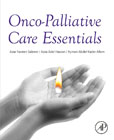
Onco-Palliative Care Essentials
Saleem, Azar Naveen
Hassan, Azza Adel
Allam, Ayman Abdel Kader
Onco-Palliative Care Essentials gives insight into the much-needed specialty to improve the quality of life of cancer patients. With a strong focus on the fundamental essentials of onco-palliative care, this book covers real-life cases with challenging cultural, existential, and social aspects.This book introduces the field of onco-palliative care to the reader, focusing on managing complex aspects associated with cancer and its treatment. It also helps the reader regarding approaches for “end of life care and discussion.” This book concludes with challenging care scenarios.Onco-Palliative Care Essentials is a very useful reference for all who are involved in cancer and palliative care, as well as those who care for cancer and terminally ill patients. . Introduces the specialty of onco-palliative care. Explains the concept of providing palliative and support care focusing exclusively on cancer patients. . Gives insights on how to diagnose and manage emergencies in palliative care. Digs into the differences involved in the legal and ethical practices with respect to the cultural and social diversities INDICE: About the authors Acknowledgments Chapter 1: Oncopalliative care essentials Objectives Chapter 2: Introduction to oncopalliative care 1 Introduction 2 Early integration of palliative care 3 Oncopalliative care: an multidisciplinary team approach 4 Oncopalliative caredobjectives 5 The focus of this book References Chapter 3: Common symptoms and management in oncopalliative care 1 Pain 1.1 Introduction 1.2 Definition of pain 1.3 A brief overview of cancer pain and its significance in oncopalliative care 1.4 Total pain 1.5 Other common types of cancer pain 1.6 Physiology of cancer pain 1.7 Cancer pain syndromes 1.8 Importance of managing cancer pain 1.9 Opioid receptors and the mechanism of their action 1.10 Common terminologies and definitions regarding opioids 1.11 Assessment of cancer pain 1.12 The pain assessment tools and “OPQRSTUV” rule of pain assessment 1.13 Management of cancer pain 2 Anxiety 2.1 Definition 2.2 Types of anxiety disorders 2.3 Prevalence of anxiety 2.4 Assessment of anxiety 2.5 Nonpharmacologic management of anxiety 2.6 Pharmacological interventions 2.7 Summary and conclusions 3 Depression 3.1 Definition 3.2 Prevalence 3.3 Assessment of depression 3.4 Nonpharmacologic management of depression 3.5 Pharmacologic management of depression 3.6 Summary and conclusions 4 Nausea and vomiting 4.1 Definition 4.2 Prevalence 4.3 Etiology and pathophysiology 4.4 Pathophysiology of nausea and vomiting 4.5 Clinical assessment of nausea and vomiting 4.6 Management of nausea and vomiting 4.7 Summary and conclusions 5 Anorexiaecachexia syndrome 5.1 Definition 5.2 Prevalence 5.3 Impact of anorexiaecachexia syndrome 5.4 Etiology and pathophysiology of anorexiaecachexia syndrome 5.5 Assessment of anorexiaecachexia syndrome 5.6 Treatment of anorexiaecachexia syndrome 5.7 Summary and recommendations 6 Cancer-related fatigue 6.1 Definition 6.2 Prevalence 6.3 Etiology 6.4 Assessment of cancer-related fatigue 6.5 Impact on patients with advanced cancer 6.6 Nonpharmacological management of cancer-related fatigue 6.7 Pharmacological treatment 6.8 Summary and conclusions 7 Dyspnea 7.1 Definition 7.2 Prevalence of dyspnea 7.3 Assessment of dyspnea 7.4 Total Dyspnea 7.5 Management of dyspnea 7.6 Summary and conclusions 8 Delirium 8.1 Definition 8.2 Prevalence of delirium 8.3 Causes of delirium 8.4 Assessment of delirium 8.5 Management of delirium AI disclosure References Chapter 4: Common emergencies in oncopalliative care 1 Introduction 2 Airway obstruction 2.1 Introduction 2.2 Causes 2.3 Presentation 2.4 Assessment 2.5 Management 3 Malignant bowel obstruction 3.1 Introduction 3.2 Causes 3.3 Presentation 3.4 Assessment 3.5 Management 4 Massive hemorrhage 4.1 Introduction 4.2 Common causes 4.3 Presentation 4.4 Assessment 4.5 Management 5 Superior vena cava syndrome 5.1 Introduction 5.2 Causes 5.3 Presentation 5.4 Diagnosis 5.5 Management 5.6 Oncopalliative care approach 6 Neoplastic spinal cord compression 6.1 Introduction 6.2 Causes 6.3 Presentation 6.4 Assessment 6.5 Management AI disclosure References Chapter 5: “End-of-life care”--An art and science 1 “End-of-life care”--Introduction 2 The role of communication in end-of-life care 3 Prognostication 4 Palliative versus hospice care 5 Advance care planning, advance directives, DNAR, and AND 6 Legal and ethical considerations in end-of-life care 7 Cultural and spiritual considerations in end-of-life care 8 Terminal phase of life 9 Grief and bereavement 10 Outcome variables that determine the quality of end-of-life care and experience AI disclosure References Further reading Chapter 6: Psychosocial aspects in oncopalliative care 1 Psychosocial caredan introduction 2 Psychosocial assessment in oncopalliative care 3 Psychosocial distress and its diagnosis 4 Oncopalliative care triangle for psychosocial support 5 Benefits of psychosocial care 6 Management of psychosocial distress AI disclosure References Chapter 7: Ethical and legal practices in oncopalliative care 1 Ethical aspects in oncopalliative care 2 The paternalistic approach to palliative care 3 The shared decision-making model 4 Determining what is in the best interest of the patients 5 The patient’s surrogate 6 Working with surrogates 7 Futility 8 Conflict of values 9 Advance care planning and advance directives 10 Do not attempt to resuscitate and allow natural death 11 Withdrawing versus withholding life-support treatment 12 Pain management at the end of life 13 Requests from the family to withhold information 14 Legal aspects in oncopalliative care 15 Summary and conclusion AI disclosure References Chapter 8: Challenging case scenarios 1 Introduction 2 Cultural challenges in oncopalliative care 2.1 Scenario 1 2.2 Scenario 2 3 Clinical challenges in oncopalliative care 3.1 Scenario 1 3.2 Scenario 2 4 Spiritual challenges in oncopalliative care 4.1 Scenario 1 4.2 Scenario 2 5 Psychological challenges in oncopalliative care 5.1 Scenario 1 5.2 Scenario 2 AI disclosure References Further reading Index
- ISBN: 978-0-443-13451-7
- Editorial: Academic Press
- Encuadernacion: Rústica
- Páginas: 196
- Fecha Publicación: 14/06/2024
- Nº Volúmenes: 1
- Idioma: Inglés
